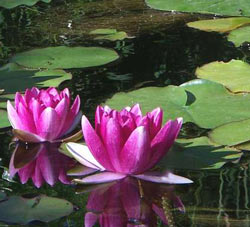
Characteristics of Hydrophytes
Hydrophytes are aquatic plants that are especially suited for living in aquatic environments. In order to survive, a hydrophyte, also known as an aquatic macrophyte, must either be completely submerged in water, or in some cases be allowed to float on the surface of the water. Aquatic plants can usually be categorized into 4 main type: floating plants, deep water plants, marginal plants and oxygenating plants. For a more in-depth description of the various types, please see our page on plants for ponds.

Definition of a Hydrophyte
As mentioned above, a hydrophyte is an aquatic plant, and while having many similarities to 'regular' plants, there are several key differences that make aquatic plants unique.
Water retention
Since plants require water to survive, plants usually posses the ability to absorb and retain water to keep the plant alive between watering cycles. Because aquatic plants are literally submersed in water at all times, there is no need for the plant to engage in water retention like non-aquatic plants. As such, there is no need for aquatic plants to expend energy to regulate transpiration, which is the loss of water in the plant due to evaporation.
Flat Leaves
In order to float on the surface of a pond, most aquatic plants have flat leaves which act as floation to a portion of the plant. An example of such a plant is the water lily, Nymphaea 'Attraction (pictured right), which is a beautiful bright red water lily that can have up to a 12 inch diameter leaf.
Feathery Roots
Because hydrophtes are supported by water rather than by roots and stem structures, most hydrophtes as a result have roots that are small and feathery. These are designed to take in oxygen from the water, and since the plant is fully submersed in water at all times, there is less need for a long and thick root structure. One plant that has a feathery root is the Salvinia Molesta, which is a free-floating aquatic fern.
Air Sacks
Often found on floating plants, many hydrophytes have air sacks that help the plant float on the surface of the water. The water chestnut is one example, which includes a beautiful cluster of green leaves with white flowers, attached to a fine root system. It is important to note that some aquatic plants will float slightly submerged in the water, such as the buttercup. Others, such as water lilies, will float up on top of the surface since their leaves distribute the weight across the surface of the water.
Buying Aquatic Plants
As with any plants, when buying aquatic plants, it is important to find plants that are local to your area or climate. In some areas, certain invasive aquatic plants have been banned, so be sure to check with your local gardening authority before purchasing any plants from a non-local source. As well, be sure to purchase healthy plants from a reputable dealer to avoid purchasing lower quality plants that may carry parasites or other contaminants that could infect your pond.
